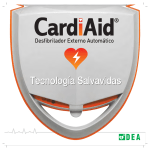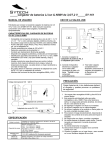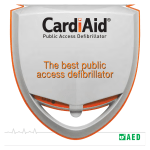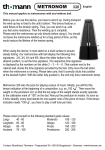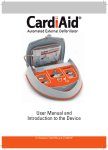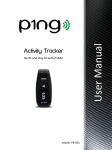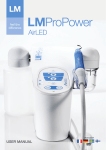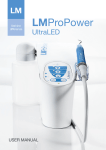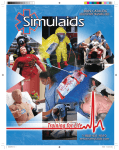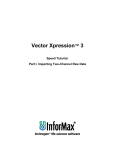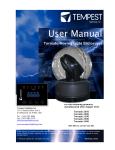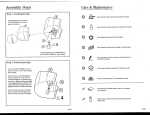Download CardiAid Catalogue
Transcript
Lifesaving Technology Lifesaver Technology for SCA Sudden cardiac arrest (SCA), the leading cause of death in USA and Europe, is the condition in which the heart is no longer able to pump blood to the brain and other organs, because of an electrical problem resulting in a fatal arrhythmia in heart. Most of the time, heart becomes chaotic (ventricular fibrillation, VF) or rapid (ventricular tachychardia, VT). SCA can strike any person, anywhere, anytime. In most cases, there are no previous symptoms. When someone collapses from SCA, immediate defibrillation and cardiopulmonary resuscitation (CPR) are essential for any chance of recovery. Immediate treatment is critical for SCA victims since survival chance decreases about 10% with every minute without defibrillation. Authorities agree that defibrillaiton should be provided as early as possible, preferably within first three to five minutes. Even with the fastest emergency medical service system, the professionals may not be able to reach the victim in time. This results in the necessity of the lifesaving defibrillation to be performed at incident scene within first minutes and by any responder. CardiAid Automated External Defibrillator (AED) is an easy-to-use device, designed specially for public access use, to provide life-saving electroshock treatment for a patient having SCA within the critical first minutes, until the professional care is available. It is an outstanding product with its innovative technology, functional design, highest production standards and impressive price performance. Beside its successful detection and treatment algorithm, CardiAid AED is perfect for public access use, because it provides comprehensive assistance to the user. CardiAid is the most user friendly defibrillator available. Where to Have CardiAid? Scientific studies have proven that immediate defibrillation is the most important factor affecting the chance of survival for SCA victims. These findings emphasized the necessity of public defibrillation. Advancing technology has enabled defibrillators to be used by non-proffesionals. Having CardiAid in these places can save many lives: • Public buildings (airports, railway stations, city halls, subway stations, shopping malls, schools) • Hotels, restaurants & bars • Outdoor sport clubs (football, basketball, volleyball, hockey, tennis, golf) • Watersports centers, swimming pools, diving clubs • Indoor sport-centers, fitness clubs • All transportation vehicles (ships, subways, buses, ferries, charter yachts, private yachts) • Ambulances, police cars, fire engines • Leisure centers (theaters, concert halls, exhibition centers, museums) • Medical clinics, pharmacies & dentists • Factories, commercial and residental buildings • Every company with one or more employees There should be a CardiAid AED in every place where; • People having higher SCA risk live, work or spend time, • SCA causing incidents may happen. Features of CardiAid CT0207 Can be used by any person with basic life support (CPR) knowledge. Provides the most efficient electroshock with biphasic waveform. Gives opportunity of applying electroshock within 1-2 minutes. Assists the user through CPR with metronomic signals for maximum efficiency. Automatically turns on when cover is opened. Automatic self-test: daily, monthly and when the device is switched on. Diagnoses the potentially life threatening cardiac arrhythmias of ventricular fibrillation and ventricular tachycardia in a patient. Pre-connected electrodes. Movement detection. Does not deliver shock if shock is not required. Automatic event documentation. Clear verbal and visual instructions prepared according to ILCOR 2005 ERC Reanimation Guideline. Special accessories providing safety easy use and best performance. How to Use CardiAid? If you notice a person lying unconscious; • First, make sure you, the victim and any bystanders are safe. • Check the victim for a response. Gently shake shoulders and ask loudly:“Are you all right?” If he responds; • Leave him in the position in which you find him, provided there is no further danger. • Try to find out what is wrong with him and get help if needed. • Reassess him regularly. If he does not respond, shout for help and follow these steps: Call the emergency number or ask another bystander to call. Turn the victim onto his back, open the airway by If signs of life are not present, bring the nearest tilting his head back and lifting his chin. Check for CardiAid AED. If there is another person, ask him signs of life (consciousness and normal breathing). to bring CardiAid AED and perform CPR until CardiAid AED arrives. CardiAid switches on automatically, when the cover of the device is opened. Follow the verbal and visual instructions. Open patient’s chest. If necessary, use the scissors Open electrodes’ package. in the emergency kit of CardiAid to cut the cloth of the patient. Peel of the film of one electrode and stick the pad Peel of the film of the second electrode and stick the CardiAid immediately starts analysing the heart on patient’s bare chest as shown on the pad. pad on patient’s bare chest as shown on the pad. rhythm. Do not touch the patient from now on. If electroshock is necessary, CardiAid informs the user and prepares the shock. CardiAid gives shock by pressing the shock button. Before pressing the button, make sure patient is not being touched or moved. CardiAid continues to guide the user through the resuscitation process. First give 30 chest compressions by following the verbal instructions of CardiAid. CardiAid provides a metronomic signal with the correct rhythm of the chest compressions. After 30 chest compressions, give 2 mouth-to-mouth breaths. Continue CPR by following the instructions of CardiAid, until “Do not touch the patient from now on.” instruction is heard. CardiAid is designed to make lifesaving defibrillation possible for everybody, accessible at everywhere. CardiAid CT0207 AED Package Content Protection Bag CardiAid AED Emergency Kit User Manual Defibrillation Electrodes Quick Reference Card Always ready to use, ready to save... CardiAid CT0207 – Technical Specifications Defibrillation System Operating Mode: Automated (one button operation) Wave Form: Biphasic, current-limited Shock Energy: Low energy (max. 181J) or high energy (max. 237J), programmable, energy adjusted to patient impedance Shock Sequence: Constant or escalating, programmable (factory setting) Charging Time: Typically <10 seconds*, maximum <15 seconds* ECG Analysis System Analysis Time: Typically <10 seconds* Derivation: II Asystole Threshold: <0,2 mV Specificity NSR/Asystole: >95** Sensitivity VF/VT: >90** Reaction to Implanted Pacemaker: Normal cardiac pacemaker rhythms are not detected as being shockable. Impedance Measurement: Checks electrodes contacts. Movement Detection: Checks the signal quality, gives acoustic warning at patient movement. Operation Operating Elements: i) Automatic switch-on when cover is opened ii) Flashing shock button (one-button operation) iii) Info-button Info Mode: Announcement of the elapsed time and number of shocks since device started, when info-button is pressed Display Elements: Self-explanatory illuminated symbols (traffic light principle) Defibrillation Electrodes Range of Application: CardiAid can be used for adult or young patients over 20 kgs. Delivery State: Disposable self-adhesive electrodes ready for use, sealed and packed with connector outside of package Polarization: Not polarized Electrode Surface Area: Each 125 cm2 Cable Length: 130 cm Shelf Life: 30 months from date of manufacture * Data are valid at 20˚C with new, fully-charged batteries. Values can vary and are dependent upon storage and environmental conditions, frequency of use, pre-configured settings and the shelf life of the product. ** The algorithm and the board of CardiAid CT0207 AED offer the optimum combination of sensitivity and specificity. (Published in “Automated analysis of electrical signals of the human body for detecting of life threatening cardiac abnormalities”, Igor Tchoudovski, Mensch and Buch Verlag, ISBN 3-89820-984-9, Page 141) Data Management Event Documentation: Automatic recording of ECG and event data in internal memory up to 4 sessions with a total maximum duration of 4 hours Data Transfer: Bluetooth (only for technical service) Event Review and Device Programming: Via bluetooth connection to PC with CardiAid Monitor Software (only for technical service) Self-Test Schedule: Automatic daily, monthly and when device is switched-on Timing: Programmable (factory setting) Scope: Battery, internal electronics, software, charging Energy Supply Type: Alkaline Monitoring Capacity: Up to 20 hours Stand-by Period: 2 Years Environmental Conditions Storage and Transport: i) 0˚C to +50˚C ii) -20˚C to +60˚C (limited to max. 2 weeks, without battery and electrodes) Operation: i) Temperature: 0˚C to +50˚C ii) Relative Humidity: 0-95% Standards Device Class: II B (93/42/EEC) Norms: EN60601-1:1998 +A1:1991 +A2:1995, EN60601-2-4:2002, EN60601-1-2:2001 +A1:2004, EN60601-1-4:1996 +A1:1999 Resuscitation Protocol: ERC, ILCOR 2005 EMC: EN60601-1-2: 2003, EN55011:1998 +A1:1999 +A2:2002, EN610004-3:2006 Protection Class: IEC 529, IPX4 (resistant to water splash) Dimensions and Weight Width: 301 mm Height: 304 mm (including handle) Depth: 112 mm Weight: 3,1 kgs (including battery and electrodes) CardiaTech, at its own discretion, reserves the right to make changes pertaining to the technical features and the accessories of the device. CardiaTech, under no condition, shall be liable for any fault of spelling and/or writing in any and all instructive and informational data, documents, images given above and any direct, indirect, accidental, secondary legal or penal loss or damages may arise from them. CardiAid Monitor Software CardiAid Monitor Lite CardiAid stores the ECG data of the patient together with the incident data such as date & time of use and number of shocks delivered in its internal memory. These data can be obtained by an authorized service provider by CardiAid Monitor Software via bluetooth connection. CardiAid Monitor Software is a comprehensive software designed for authorized service providers of CardiAid. With CardiAid Monitor Software, the service provider can; • Receive the ECG and incident data from the device and form an “incident report”, • View device settings, • Perform maintenance to CardiAid. CardiAid Monitor Mini CardiAid Monitor Mini is a special software which can be used with PDAs which have bluetooth connection. It can be used by authorized service providers and emergency medicine personnel who would like to reach to the ECG data of the patient. With CardiAid Monitor Mini, the user can view device settings, ECG & incident data and send the incident report via e-mail. * CardiAid Monitor Lite is compatible with Microsoft XP or higher. CardiAid Monitor Mini is compatible with Microsoft Windows Mobile 6 or higher. CardiAid Trainer (Model Nr. CT0207T) CardiAid AED is an easy to use device. It guides the user with clear verbal and visual instructions. However when a person is having SCA, the situation will be stressful, hectic and even chaotic. It is advised for potential users of CardiAid to have training with CardiAid Trainer which was developed specially for this purpose. CardiAid Trainer is designed considering special needs for AED training: It has the same appearance with CardiAid AED, aimed to make trainees familiar with the product. It can simulate all possible scenarios a user may face when using CardiAid AED and the user will be trained about the actions to take in each situation. It is operated by the instructor with remote control. The instructor may set different scenarios instantly according to the need of each user and/or the subject of the training session. It can operate in 20 languages: English, French, German, Dutch, Turkish, Italian, Spanish, Portuguese, Brazilian Portuguese, Danish, Norwegian, Swedish, Finnish, Russian, Polish, Czech, Arabic, Persian, Chinese-Mandarin and Chinese-Cantonese. CardiAid CPREzy External Chest Compression Assistant (Model Nr. CCPR01) Guiding the user to perform effective chest compressions during CPR, CardiAid CPREzy ECC Assistant helps the rescuer achieve correct compression rate and depth according to CPR guidelines. During the CPR cycle of CardiAid AED, CardiAid CPREzy is a perfect assistant of the user for performing external chest compressions. It indicates the required compression force with pressure-sensitive flashing lights according to the weight category of the patient. With metronomic signals and flashing lights, CardiAid CPREzy ECC Assistant provides the correct speed rhythm for compressions. The chest map on the device shows the correct position to apply chest compressions. CardiAid CPREzy ECC Assistant can also be used for training purposes by helping the users to adopt the correct depth and rate of the compressions. CardiAid AED Accessories CardiAid AED Cabinet When someone suffers sudden cardiac arrest, every second is critical. In a public place, it may be a problem for the responder to know whether there is an AED on site and bring the AED to the scene. On the other hand, the AED should be protected when in a public place; like airports, city halls, schools etc. For this reason, CardiAid AED should be stored where it may be noticed and reached quickly while providing safety of the device. (Model Nr: CC001W) With its design, CardiAid AED Cabinet ensures CardiAid AED to be noticeable and easily reachable in an emergency. It has alarm and strobe light which are activated when the door is opened. This provides the authorized personnel of the public place to be informed that there is an emergency and also helps providing safety of the device. For further precaution, the owner may also prefer to use the key which is provided with the cabinet, when needed. CardiAid AED Cabinet is easy to use. It uses a standard 9V alkaline battery for power source, therefore does not need any electrical connection. The battery may be changed easily by the user. CardiAid AED Cabinet is an effective and essential element of an AED program of a public place. Implementation of CardiAid for Public Places Optional Features & Accessories: • Sending SMS when door is opened • Digital Lock •Temperature & Humidity Control • Brochure Holder Information Board for AED Cabinet: CDC01B001 Instruction Board for AED Cabinet: CDC01B002 CardiAid Wallmount (Model Nr: CT0207W) CardiAid Wallmount provides practical storage for CardiAid AED. With CardiAid Wallmount, CardiAid AED is easy to notice and easy to access. CardiAid Wallmount enables quicker response, which is critical in an SCA event. CardiAid Wallmount also provides storage for spare electrodes, where necessary (optional). Wallmount Board: CDC01WMB001 AED Signs and Flags In case of SCA, every second counts. It is critical for the AED to be easily noticed and reached by the responder. Mark the location of your AED with AED wall signs, direction AED Wall Sign Model Nr: AS001PG AED Flag Model Nr: AF003G signs and flags. Make sure that your facility’s AED is easy to find and make further assistance for saving a life by reducing the emergency response time. AED Equipped Building Sign Model Nr: AS004PG AED Direction Sign Model Nr: AS002PG AUTHORIZED DISTRIBUTOR/RESELLER Ditlaar 7, 1066 EE Amsterdam, The Netherlands T: +31(0)20-5106 900 F: +31(0)20-5106 909 www.cardiaid.com
















